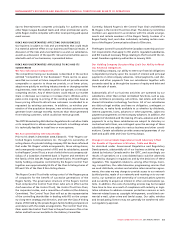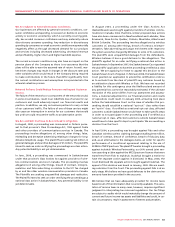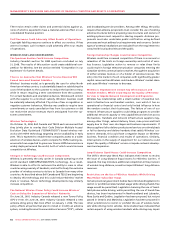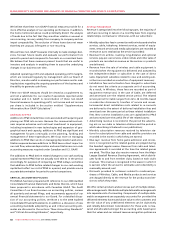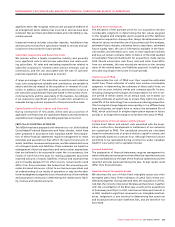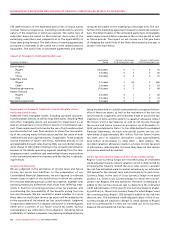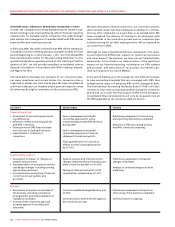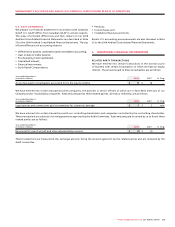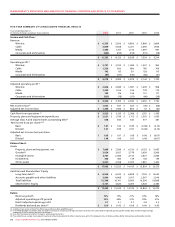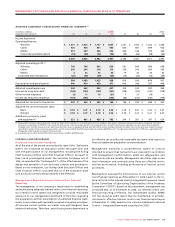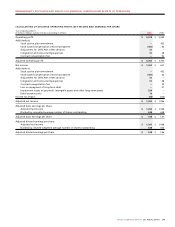Rogers 2008 Annual Report Download - page 74
Download and view the complete annual report
Please find page 74 of the 2008 Rogers annual report below. You can navigate through the pages in the report by either clicking on the pages listed below, or by using the keyword search tool below to find specific information within the annual report.
70 ROGERS COMMUNICATIONS INC. 2008 ANNUAL REPORT
MANAGEMENT’S DISCUSSION AND ANALYSIS OF FINANCIAL CONDITION AND RESULTS OF OPERATIONS
The determination of the estimated useful lives of brand names
involves historical experience, marketing considerations and the
nature of the industries in which we operate. The useful lives of
subscriber bases are based on the historical churn rates of the
underlying subscribers and judgments as to the applicability of
these rates going forward. The useful lives of roaming agreements
are based on estimates of the useful lives of the related network
equipment. The useful lives of wholesale agreements and dealer
Impact of Changes in Estimated Useful Lives
Amortization Increase in Net Income Decrease in Net Income
(In millions of dollars) Period if Life Increased by 1 year if Life Decreased by 1 year
Brand names
Rogers 20.0 years $ 1 $ (1)
Fido 5.0 years $ 3 $ (5)
Citytv 5.0 years $ 0 $ (1)
Subscriber base
Rogers 4.7 years $ 30 $ (46)
Cable 3.0 years $ 2 $ (3)
Roaming agreements 12.0 years $ 3 $ (4)
Dealer network
Rogers 4.0 years $ 1 $ (2)
Fido 4.0 years $ 1 $ (1)
Marketing agreement 5.0 years $ 1 $ (1)
networks are based on the underlying contractual lives. The use-
ful life of the marketing agreement is based on historical customer
lives. The determination of the estimated useful lives of intangible
assets impacts amortization expense in the current period as well
as future periods. The impact on net income on a full-year basis
of changing the useful lives of the finite-lived assets by one year is
shown in the chart below.
Impairment of Goodwill, Indefinite-Lived Intangible Assets
and Long-Lived Assets
Indefinite-lived intangible assets, including goodwill and spec-
trum/broadcast licences, as well as long-lived assets, including PP&E
and other intangible assets, are assessed for impairment on at
least an annual basis or more often if events or circumstances war-
rant. These impairment tests involve the use of both undiscounted
and discounted net cash flow analyses to assess the recoverabil-
ity of the carrying value of these assets and the fair value of both
indefinite-lived and long-lived assets, if applicable. These analyses
involve estimates of future cash flows, estimated periods of use
and applicable discount rates. During 2008, we recorded an impair-
ment charge of $294 million relating to the conventional television
business in the Media operating segment resulting from the chal-
lenging economic conditions and weakening industry expectations
in the conventional television business and the decline in advertis-
ing revenues.
Income Tax Estimates
We use judgment in the estimation of income taxes and future
income tax assets and liabilities. In the preparation of our
Consolidated Financial Statements, we are required to estimate
income taxes in each of the jurisdictions in which we operate.
This involves estimating actual current tax expense, together with
assessing temporary differences that result from differing treat-
ments in items for accounting purposes versus tax purposes, and
in estimating the recoverability of the benefits arising from tax
loss carryforwards. We are required to assess whether it is more
likely than not that future income tax assets will be realized prior
to the expiration of the related tax loss carryforwards. Judgment
is required to determine if a valuation allowance is needed against
either all or a portion of our future income tax assets. Various
considerations are reflected in this judgment, including future
profitability of related companies, tax planning strategies that are
being implemented or could be implemented to recognize the ben-
efits of these tax assets, as well as the expiration of the tax loss
carryforwards. Judgments and estimates made to assess the tax
treatment of items and the need for a valuation allowance impact
the future income tax balances as well as net income through
the current and future income tax provisions. As at December 31,
2008, and as detailed in Note 7 to the 2008 Audited Consolidated
Financial Statements, we have non-capital income tax loss car-
ryforwards of approximately $911 million. Our net future income
tax asset, prior to valuation allowances, totals approximately
$246 million at December 31, 2008 (2007 – $609 million). The
recorded valuation allowance results in a future income tax asset
of $144 million, reflecting that it is more likely than not that certain
income tax assets will be realized.
Credit Spreads and the Impact on Fair Value of Derivatives
Rogers’ Cross-Currency Swaps are recorded using an estimated
credit-adjusted mark-to-market valuation which is determined by
increasing the treasury-related discount rates used to calculate
the risk-free estimated mark-to-market valuation by an estimated
CDS Spread for the relevant term and counterparty for each Cross-
Currency Swap. In the case of Cross-Currency Swaps in an asset
position (i.e., those Cross-Currency Swaps for which the counter-
parties owe Rogers), the CDS Spread for the bank counterparty is
added to the risk-free discount rate to determine the estimated
credit-adjusted value. In the case of Cross-Currency Swaps in a liabil-
ity position (i.e., those Cross-Currency Swaps for which Rogers owes
the counterparties), Rogers’ CDS Spread is added to the risk-free
discount rate. The estimated credit-adjusted values of the Cross-
Currency Swaps are subject to changes in credit spreads of Rogers
and its counterparties. In 2007, we recorded our Cross-Currency
Swaps at the estimated risk-free fair value.



